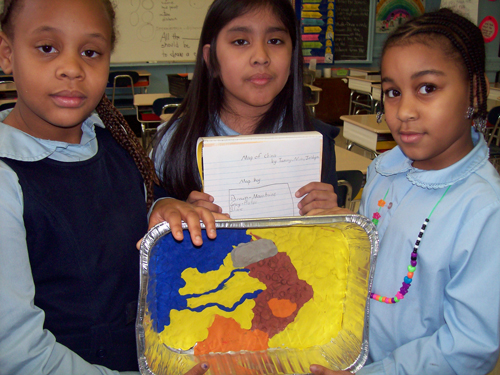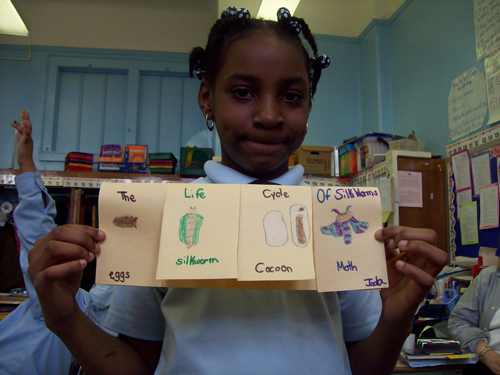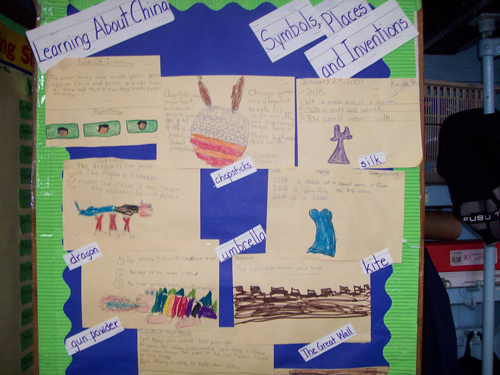Our State Road Trip
| Name: |
Lori Gordon |
| School: |
PS 35X |
| Address: |
261 East 163rd Street |
| City: |
Bronx, NY, 10451 |
| Original Project: |
Our State Road Trip |
| Author: |
Ms. M. Woods |
| URL: |
http://teachersnetwork.org/teachnet-lab/miami/2001/woodsm.htm |
How did you modify this unit for use in your own classroom?: Instead of a virtual tour of Florida, students "toured" the country of China.
List your primary instructional objectives for your students.
| |
Geography/Map Skills: different types of maps (physical/political maps), parts of maps (key/legend, compass rose, map symbols); using latitude and longitude to help locate places; hemispheres |
| |
Science: life cycle of the silk worm--metamorphosis; cultivation of the silk worm to make silk; climate/weather and how it impacts agriculture; time differences; the endangered Panda and its habitat |
| |
Language Arts: compare/contrast culture and customs in the USA with culture and customs in China; identify and write about folk literature; note taking; identify facts/details; symbols |
| |
History/Culture: Chinese inventions, customs of honoring ancestors, holiday celebrations; places of interest: The Great Wall, Forbidden City/Palace Museum; Terra Cotta Warriors |
What role did technology play in this curriculum unit?: Students who have a computer at home used the Internet to research the customs and culture of China. Web sites used included: Askasia.org enchantedlearning cobblestonepublishing.com bookrags.com tooter4kids.com asiaforkids.com beginnersguide.com/china
How did you assess and evaluate student performance?: Student writing was used to assess each project as well as participation. In addition, students also delivered oral reports. A class rubric was developed for each project. Rubric for Physical Map Project: 3 Map includes country borders 5 landforms Bodies of water Labels for each landform and body of water Descriptions of the landforms A color coded map key Neat, legible Includes a short narrative that explains the map, nd is factually correct 2 Map includes Some country borders Less than 5 landforms Some bodies of water (some may be missing) Partial descriptions of the landforms A color coded map key Includes a short narrative that has some facts; some facts may be wrong 1 We do not believe in or accept level 1. Rubric for Life Cycle of the Silk Worm (Science) 3 Illustrations include all the stages of a silkworm from Egg to caterpillar, cocoon to moth Narrative explanation of each stage Showing understanding of the process Uses scientific vocabulary Presentation is neat and legible 2 Illustrations include some of the stages of the silkworm life cycle Narrative is explanation shows some understanding But may have omitted basic facts, or is Factually incorrect Limited use of scientific vocabulary Presentation is acceptable but could be neater Standards: World History Standard 2 "Students will use a variety of intellectual skills to demonstrate their understanding of major ideas, eras, themes, developments, and turning points in world history and examine the broad sweep of history from a variety of perspectives." Performance Indicators: Read historical novels, myths, legends, biographies and autobiographies to learn about how historical figures lived, their motivations,hopes, fears, strengths and weaknesses. Study about different world cultures and civilizations focusing on their accomplishments, contributions, values, beliefs and traditions. Distinguish between past, present and future time periods. Develop timelines that display important events from world history. Gather and present information about important developments from world history. Explore the lifestyles, beliefs, traditions rules and laws ...during different periods in history in different parts of the world. Geography Performance Indicators Draw maps and diagrams that serve as representations of places, physical features and objects. ...Locate the earth's continents in relation to each other and to principal parallels and meridians. Identify and compare physical, human and cultural characteristics of different regions and people.
Please tell us briefly about your background & teaching experience: After a successful career as a Director of Resource Development in museums and other nonprofit educational settings, Ms. Gordon changed careers in 1998 to become an elementary school teacher. At PS 35, she taught fourth and most recently third grade. She served as grade leader of the fourth grade for 6 years. In this position, she acted as a liaison between administration and her teaching colleagues on the grade. She also coordinated family communications, planned trips, planned and coordinated the fourth grade promotion ceremony as well as senior class trip. She also acted as a social studies representative from her school at Regional meetings. In 2004, she became one of New York City's first 35 Lead Teachers, a position she currently holds. As a lead teacher, she spends half her time in her own class and the other half of her time helping teachers in their quest to become better at what they do. In this capacity, she attends and delivers professional development as needed.
What are your recommendations for other teachers interested in adapting this unit?:
The unit will take about six to eight weeks to complete (2-45 minute class periods a week). There is a page that addresses New York State standards; key vocabulary, materials and graphic organizers used, assessment rubric.
Samples of Student Projects
| |
Using modeling clay and foil baking tins, students created a relief map of China to show landforms including mountains, plateaus, deserts, plains, and bodies of water. |
| |
 |
| |
|
| |
Students examined specimens of the silkworm at each state of development and created their own explanation of metamorphosis. |
| |
 |
| |
|
| |
Students took notes in a travel diary notebook about "places" they visited. Students wrote postcards about their experiences. |
| |
|
| |
 |
| |
|
| |
Students researched a report about a Chinese invention (ex: chopsticks, paper, gunpowder, porcelain, kite, umbrella etc.). They wrote a report and delivered it orally to the class. |
|